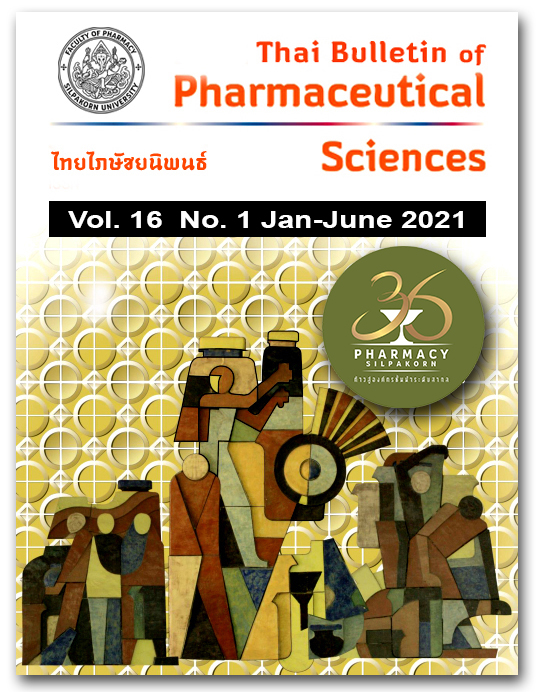จุดตัดที่เหมาะสมสำหรับการวิเคราะห์เส้นโค้ง Receiver Operating Characteristic (ROC) ในการพัฒนาเครื่องมือนวัตกรรมทางสุขภาพ: กรณีตัวอย่างโดยใช้โปรแกรม STATA
DOI:
https://doi.org/10.69598/tbps.16.1.93-108คำสำคัญ:
กราฟเส้นโค้ง ROC, จุดตัดที่เหมาะสม, ดัชนีของ Youden, พื้นที่ใต้โค้ง AUC, นวัตกรรมทางสุขภาพบทคัดย่อ
การวิเคราะห์เส้นโค้ง receiver operating characteristic (ROC) เป็นวิธีการที่ถูกนำมาใช้ค่อนข้างแพร่หลายในการวินิจฉัยโรค แต่ในการพัฒนานวัตกรรมทางสุขภาพยังคงพบน้อยและไม่ชัดเจนสำหรับแนวปฏิบัติ บทความนี้จึงได้นำเสนอหลักการและตัวบ่งชี้สำหรับการประเมินความถูกต้องของวิธีการวินิจฉัยโรค และการพิจารณาจุดตัดที่เหมาะสม 3 วิธี ได้แก่ วิธี Euclidian’s index วิธี Youden’s index และวิธี Weighted Number Need to Misdiagnose (Weighted NNM) รวมถึงการประเมินประสิทธิภาพการจำแนกความถูกต้องโดยรวมของเครื่องมือที่เป็นนวัตกรรมทางสุขภาพทั้งแบบวิธีเดียวและแบบเปรียบเทียบสองวิธี ด้วยพื้นที่ใต้โค้ง ROC หรือ area under the curve (AUC) ตัวอย่างถูกสาธิตโดยใช้คำสั่งในโปรแกรม STATA ขณะที่ผลลัพธ์และค่าสถิติที่เกี่ยวข้องยังคงถูกนำเสนอและแปลความหมายด้วยเช่นกัน สุดท้ายเป็นข้อเสนอแนะในการนำวิธีการวิเคราะห์เส้นโค้ง ROC ไปใช้ ซึ่งครอบคลุมทั้งจุดเด่นและข้อจำกัด
เอกสารอ้างอิง
Habibzadeh F, Habibzadeh P, Yadollahie M. On determining the most appropriate test cut-off value: the case of tests with continuous results. Biochem Med (Zagreb). 2016;26(3):297-307.
Tripepi G, Jager KJ, Dekker FW, Zoccali C. Diagnostic methods 2: receiver operating characteristic (ROC) curves. Kidney Int. 2009;76(3):252-6.
Ren Q, Su C, Wang H, Wang Z, Du W, Zhang B. Prospective study of optimal obesity index cut-off values for predicting incidence of hypertension in 18-65-year-old Chinese adults. PloS one. 2016;11(3):e0148140-e0148140.
Silva PAB, Soares SM, Santos JFG, Silva LB. Cut-off point for WHOQOL-bref as a measure of quality of life of older adults. Rev Saude Publica. 2014;48(3):390-7.
Westergren A, Norberg E, Vallén C, Hagell P. Cut-off scores for the Minimal Eating Observation and Nutrition Form – Version II (MEONF-II) among hospital inpatients. Food Nutr Res. 2011;55(1):7289.
Sung YH, Cho MS, Kwon IG, Jung YY, Song MR, Kim K, et al. Evaluation of falls by inpatients in an acute care hospital in Korea using the Morse Fall Scale. Int J Nurs Pract. 2014;20(5):510-7.
Kim HR, Kim HS. Optimal cutoffs of cardiometabolic risk for postmenopausal Korean women. Asian Nurs Res (Korean Soc Nurs Sci). 2017;11(2):107-12.
Chan KTM, Cheung AHN. Application of receiver operating characteristic (ROC) curve to determine the diagnostic ability of a validated ten-item questionnaire (SS - 10) in estimating the prevalence of sensitive skin in Hong Kong population. Int J Inn Res Med Sci. 2019;4(07):405-13.
Sidey-Gibbons JAM, Sidey-Gibbons CJ. Machine learning in medicine: a practical introduction. BMC Med Res Methodol. 2019;19(1):64.
Kumar R. Indrayan A. Receiver operating characteristic (ROC) curve for medical researchers. Indian Pediatr. 2011;48(4):277-87.
Zou KH, O’Malley AJ, Mauri L. Receiver-operating characteristic analysis for evaluating diagnostic tests and predictive models. Circulation. 2007;115(5):654-7.
Hajian-Tilaki K. The choice of methods in determining the optimal cut-off value for quantitative diagnostic test evaluation. Stat Methods Med Res. 2018;27(8):2374-83.
Perkins NJ, Schisterman EF. The inconsistency of "optimal" cutpoints obtained using two criteria based on the receiver operating characteristic curve. Am J Epidemiol. 2006;163(7):670-5.
Habibzadeh F, Habibzadeh P, Yadollahie M. Criterion used for determination of test cut-off value. Diabetes Res Clin Pract. 2017;128:138-9.
Habibzadeh F, Yadollahie M. Number needed to misdiagnose: a measure of diagnostic test effectiveness. Epidemiology. 2013;24(1):170.
DeLong ER, DeLong DM, Clarke-Pearson DL. Comparing the areas under two or more correlated receiver operating characteristic curves: a nonparametric approach. Biometrics. 1988;44(3):837-45.
Metz CE. Basic principles of ROC analysis. Semin Nucl Med. 1978;8(4):283-98.
Ray P, Manach YL, Riou B, Houle TT. Statistical Evaluation of a Biomarker. Anesthesiology. 2010;112(4):1023-40.
Mandrekar JN. Receiver operating characteristic curve in diagnostic test assessment. J Thorac Oncol. 2010;5(9): 1315-16.
Kamarudin AN, Cox T, R Kolamunnage-Dona. Time-dependent ROC curve analysis in medical research: current methods and applications. BMC Med Res Methodol. 2017;17(1):53.
Pepe M, Longton G, Janes H. Estimation and comparison of receiver operating characteristic curves. Stata J. 2009;9(1):1.
Demler OV, Pencina MJ, D'Agostino RB Sr. Misuse of DeLong test to compare AUCs for nested models. Stat Med. 2012;31(23):2577-87.



